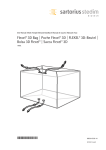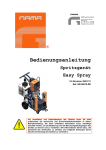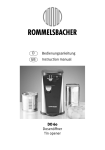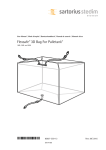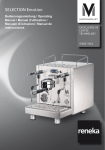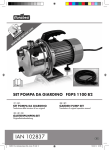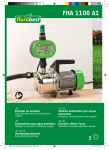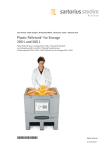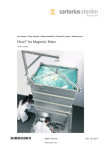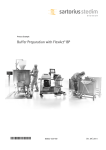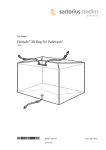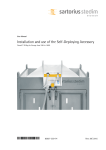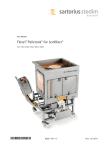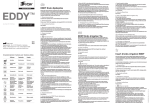Download Flexel® 3D Bag
Transcript
User Manual |Mode d’emploi |Benutzerhandbuch|Manual de usuario|Manuale d'uso Flexel® 3D Bag | Poche Flexel® 3D | Flexel® 3D Bag | Bolsa 3D Flexel® | Sacche Flexel® 3D 1 500L | 3 000L 85034-535-64 IU101214 rev01 Table of Contents English page 2 1. Introduction 3 Français page 8 2. Deutsch Seite 14 2.1. 2.2. Palletank® & Flexel® 3D Bag Description Palletank® Description Flexel® 3D Bag Description 3 3 3 Español página 20 Italiano pagina 26 3.1. 3.2. 3.3. 3.4. Flexel® 3D System 1500L to 3000L Instructions for Use Preparation of the Palletank® Flexel® 3D Bag Installation Flexel® 3D Bag Filling Flexel® 3D Bag Emptying 4 4 4 4 5 4. Trouble Shooting Guide 5 5. Precautions of Use 5 6. Flexel® 3D Bag Storage Conditions 6 7. Shelf Life of a Flexel® 3D Bag 6 8. Product Complaint 6 9. Disclaimers 7 10. Warranty 7 11. Trademark & Patents 7 3. 2 Flexel® 3D BAG 1500L | 3000L 1. Introduction 2. Palletank® & Flexel® 3D Bag Description For use with: Palletank® For In-Process Fluid Handling: 1500L, 2000L, 2500L and 3000L The Flexel® 3D System is composed of a disposable sterile bag, the Flexel® 3D Bag and the Palletank® rigid container constructed of stainless steel. The Palletank® supports the fluid contained within the Flexel® 3D Bag. The two make up the System and must be used together to ensure a robust process solution. The Flexel® 3D Bags are manufactured according to a patented design that precisely fits the Palletank®. When filling, bottom and sides of the bag conform exactly to the shape and dimensions of the tank. The exact fit ensures that there are no folds or creases to trap pockets of air or liquid for maximum bag functionality. The Flexel® 3D System has been designed with bottom ports that allow both bottom filling and drainage of the bag for virtually 100% fluid recovery. The various configurations of tubing and the Palletank® make it compatible with a wide range of bio-processing applications. Bags and corresponding Palletank® for In-Process Fluid Handling are currently available from 1500L to 3000L. 2.1. Palletank® Description Sartorius Stedim Biotech currently offers the Palletank® For In-Process Fluid Handling for use with 1500L to 3000L Flexel® 3D Bags. (See Fig. 1) 2.2. Flexel® 3D Bag Description (See Fig. 2) Purpose This Instruction for use describes the operations required to prepare, fill and drain the Flexel® 3D Bag in its dedicated Palletank® from 1,500L and above. 3 3. Flexel® 3D System 1500 L to 3000 L Instructions for Use 3.1. Preparation of the Palletank® a) Open the hinged front and side doors by removing the locking systems (See Fig. 4) b) Before proceeding to Flexel® 3D Bag installation in the Palletank®, check that the internal surfaces of the Palletank® are SMOOTH, FREE OF ANY PARTICLES that might damage the bag surface and DRY c) Open the three bottom gates (See Fig 3): - Do not open the bottom gates when the Flexel® 3D Bag is filled (Failure to follow this instruction may result in product loss) - Remove the retaining clip from the retaining clip fastening point. - Grasp the retaining clip fastening point and swing the bottom gate completely open. - Repeat the procedure for the two remaining bottom gates. d) If needed, remove the stainless steel hanger from the limit stopper (See Fig. 1). 3.2. Flexel® 3D Bag Installation a) Obtain a packaged Flexel® 3D Bag of the appropriate size (bag size matches Palletank® size) and position it on a smooth table with no sharp angular corners. b) Check that the irradiation indicator on the label is red and record the batch number of the bag (as seen on the product label). (See Fig. 5) c) On a table, position the bag in such a way that the bottom ports are underneath and facing you. This correct positioning will ensure a proper insertion of the Flexel® 3D Bag in the Palletank® (See Fig. 7) d) To open the secondary (external) packaging (See Fig. 6): - cut one of its corner just under the closure weld with a pair of rounded scissors and open completely by tearing along the weld. - Remove the secondary packaging by sliding it away from the Flexel® 3D Bag. e) Check that the Flexel® 3D bag secondary packaging is free from any damage that could compromise the sterility. f) Repeat the d) and e) steps for the primary (internal) packaging. g) Remove the adhesive tape at the top of the bag and the protective foam from the Flexel® 3D Bag without unfolding the bag (See Fig 7). 4 h) Bag positioning inside the Palletank® hold the folded bag on both arms with the three bottom ports underneath (See Fig. 8) - Position yourself in front of the Palletank®. - Introduce the folded bag in the Palletank® by the front opening in such a way that the bottom ports face the bottom gates. The accordion pleats of the bag have been especially designed to facilitate its manipulation, installation in the Palletank® and unfolding during hoisting of the bag. i) Pass the bottom port tubes thought the front channels, coil them to position these in the Palletank® bottom plate. j) Insertion of the bottom port tubes in the bottom gates: - Insert the bottom port tube and pull it through the jaw. - Place the bottom port in contact with the fixed jaw of the bottom gate. The edge of the fixed jaw must be inserted inside the groove of the bottom port. (See Fig. 9) - Slightly pull down the bottom port and close the mobile jaw inside the groove of the bottom port. (See Fig. 10) - Lock the latch of the bottom gate to secure the bottom port. (See Fig. 3) - Check the correct positioning of the bottom port in the bottom gate by trying to pull the bottom port out from the bottom gate. The bottom port must remain in place. If it is not the case, repeat the j) step. - Repeat the same operations for the two other bottom port tubes positioning in the bottom gates k) Position the clamps on the bottom tubes as close as possible to the bottom ports and close them (See Fig. B). l) Pass and lock-in the four stainless steel hooks of the cable positioned through corresponding holes located on the Flexel® 3D Bag top flaps. (See Fig. 11 and Fig. 12) m) Pull the stainless steel hanger of the cable to lift the Flexel® 3D Bag until the limit stopper of the hanger. Attach the hanger to the limit stopper (See Fig. 13). The bag is ready for the filling operation. n) Check that the K-seal is in the middle and parallel to the front and back of the container (See Fig. 14). 3.3. Flexel® 3D Bag Filling a) Check that all the clamps are closed. (See Fig. B) b) Open the connector protective outerwrap using the reversible cable tie on the bottom filling line (See Fig. C) and connect the bag to the supply tank in accordance with the standard procedures used on your site. c) Open the clamps on the tubing line that the bag will be filled from. (See Fig. A) d) Start to fill the Flexel® 3D Bag - Sartorius Stedim Biotech recommends the use of peristaltic pumps for filling and dispensing from the bag. (See Fig. 15) e) After having filled the bag with 1- 2% of the bag nominal volume: - Stop filling the bag - Using the front doors access, manually adjust front bag corners the corresponding Palletank® angles - Using the side openings, manually adjust backside bag corners to the corresponding Palletank® angles (See Fig. 16) - Continue the filling until the full bottom surface of the Palletank® is covered with liquid. f) Close front and side doors and secure locking systems (See Fig. 17) g) When filling is complete, close the clamps (See Fig. B) and disconnect the filling line. 3.4. Flexel® 3D Bag Emptying a) Warning: Before starting bag emptying, remove the stainless steel hanger from its limit stopper (See Fig 18). b) Take the bottom port tube and position it vertically. Open the connector protective outer-wrap using the reversible cable tie on the dispensing line and carry out the connection according to the standard procedures that apply on the site (See Fig. C). c) Unclamp the drain line and start the draining operation (See Fig. A) - Gravity can be used, but for faster draining Sartorius Stedim Biotech recommends the use of a peristaltic pump. (See Fig. 19) d) The Flexel® 3D Bag closes down on itself and collapses automatically. To obtain 100% fluid recovery, lift the collapsed bag. e) When dispensing is complete, clamp the line (See Fig. B) and disconnect the main drain line from the drain tube of the Flexel® 3D Bag. f) Remove each stainless steel hook of the cable from holes located on the Flexel® 3D Bag top flaps. g) Open the three bottom gates to free the bottom ports by removing the retaining clip from the retaining clip fastening point; then grasp the retaining clip fastening point and swing the bottom gate open. 4. Trouble Shooting Guide 5. Precautions of Use The bag will not fill > Check that the clamp is open and that the tube is not pinched. a) The Sartorius Stedim Biotech Flexel® 3D Bag must imperatively be used with the Sartorius Stedim Biotech Palletank®. When filling through the bottom, the bag comes out of the bottom gate. > The edge of the jaw is not closed inside the groove of the bottom port. Position it correctly in the groove. b) The Palletank® must be clean and dry before inserting the Flexel® 3D Bag. Traces of cleaning agents left on the Palletank® can potentially damage the Flexel® 3D Bag. The bag does not open out correctly during filling: > The port system is incorrectly aligned. The bag is incorrectly positioned in the Palletank®. Lift the bag out of the Palletank®, turn it round and go through Flexel® 3D Bag installation procedure once again. > The bottom of the bag is incorrectly positioned. Place the corners of the bag in the corners of the Palletank® (make sure that only 1-2% of nominal volume is filled before adjusting, otherwise bag failure may occur) c) It is under the user’s responsibility to verify the compatibility of the Flexel® 3D Bag materials with the solutions used in your process. Sartorius Stedim Biotech can provide guidelines for chemical compatibility, bio-compatibility and extractables. Many folds appear in the bag during filling > The bag is too big, use the bag suited to the size of the Palletank® The bag does not come up against the walls > The bag is too small, use the bag suited to the size of the Palletank® The bag will not drain > Check that the clamp is open and that the tube is not pinched. d) Avoid leaving sharp objects (scissors, cutters, scalpels, etc.) in the vicinity of the Flexel® 3D Bag. e) The Flexel® 3D Bag is not to be handled by its connections (i.e. tubing). f) Avoid folding the Flexel® 3D Bag other than the original folds. Do not fold the bag in the direction of the “gussets”. (Gussets Heat-sealed seams) g) When positioning the Flexel® 3D Bag in the Palletank® and when adjusting it after the initial fill, handle the bag gently and do not force fit or pull hard. h) The Flexel® 3D Bag is for single-use and should not be re-used. h) Remove the collapsed bag from the Palletank® (See Fig. 20). 5 6. Flexel® 3D Bag Storage Conditions 7. Shelf Life of a Flexel® 3D Bag Flexel® 3D Bags can be stored in their original primary packaging at room temperature (5°C to 40°C), in a dry environment. The shelf life after gamma sterilisation has been validated as indicated on the labelling (product packaging and case) and in the specifications. Details are available from Sartorius Stedim Biotech upon request. 8. Product Complaint When may a complaint occur? When a malfunction or deterioration in the characteristics and/or performance of a marketed product as well as any inadequacy in the labelling, instructions for use, release certificate and/or customer services have occurred. To whom should the complaint be sent? To your Sartorius Stedim Biotech commercial contact person or distributor. How and which information should be conveyed? A complaint form is available at http://www.sartorius-stedim.com and should be sent by e-mail, fax or letter with: – the defect description; – the description of the process in which the defect was detected; – the bag or bag system traceability (product code & lot number). The bag or device deemed defective is required to perform the investigation. 6 9. Disclaimers 10. Warranty 11. Trademark & Patents a) Sartorius Stedim Biotech Flexel® 3D Bag is for SINGLE-USE only. Sartorius Stedim Biotech will not endorse any responsibility of any kind for re-use of the Flexel® 3D Bag. Sartorius Stedim Biotech warrants that the Flexel® 3D Bag is produced according to specifications. Unless otherwise provided for in agreed upon specifications, the general Sartorius Stedim Biotech specifications will apply. In the case of defect, please follow the above mentioned product complaint procedure. a) Flexel® and Palletank® are registered trademarks of Sartorius Stedim Biotech. b) Sartorius Stedim Biotech will not accept any responsibility for use of Flexel® 3D Bag with any other container than Palletank®. b) The Flexel® 3D System is covered by 2 patents filed internationally. c) Sartorius Stedim Biotech will not endorse any responsibility if the Flexel® 3D Bag instructions for use as described in this document are not strictly followed and the above mentioned Precautions of Use applied. Upon request, Sartorius Stedim Biotech engineers can perform training of employees. d) Sartorius Stedim Biotech is not responsible for any special, incidental or consequential damages resulting from any legal theory, including lost profits, downtime, goodwill, damage to or replacement of equipment or property. 7 Table des matières 1. Introduction 9 2. Description du Palletank® et de la Poche Flexel® 3D Description du Palletank® Description de la Poche Flexel® 3D 9 9 9 Mode d'emploi du Système Flexel® 3D de 1 500 l à 3 000 l Préparation du Palletank® Installation de la Poche Flexel® 3D Remplissage des Poche Flexel® 3D Vidange des Poche Flexel® 3D 10 10 10 10 11 Incidents de Fonctionnement : Origines et Solutions 11 5. Précautions d'emploi 11 6. Conditions de Stockage de la Poche Flexel® 12 Durée de Conservation des Poches Flexel® 3D 12 8. Réclamations 12 9. Clauses de Non-Responsabilité 13 10. Garantie 13 11. Marques et Brevets 13 2.1. 2.2. 3. 3.1. 3.2. 3.3. 3.4. 4. 7. 8 Poche Flexel® 3D 1 500 L | 3 000 L 1. Introduction 2. Description du Palletank® et de la Poche Flexel® 3D À utiliser avec : Palletank® pour la manutention de fluides en cours de traitement : 1 500 L, 2 000 L, 2 500 L et 3 000 L Le système Flexel® 3D se compose d'une poche stérile à usage unique, la poche Flexel® 3D et d'un conteneur rigide, le Palletank® en acier inoxydable. Le Palletank® maintient la poche Flexel® 3D contenant le fluide. Les deux dispositifs forment le système et doivent être utilisés ensemble pour obtenir une solution de traitement robuste. Les poches Flexel® 3D sont fabriquées selon une conception brevetée parfaitement adaptée au Palletank®. Pendant le remplissage, le fond et les côtés de la poche épousent parfaitement la forme et les dimensions du conteneur. Cette compatibilité garantit l'absence de pliures et de faux-pli qui peuvent former des poches d'air ou de liquide et veille au fonctionnement parfait de la poche. Le système Flexel® 3D a été conçu avec des lignes basses permettant le remplissage et la vidange par le bas de la poche pour une récupération presque totale du liquide. Les différentes configurations de tubes et le Palletank® assurent la compatibilité avec une large gamme d'applications biotechnologiques. Les poches et les Palletank® pour la manutention de fluides en cours de traitement sont actuellement disponibles de 1 500L à 3 000L. 2.1. Description du Palletank® Sartorius Stedim Biotech propose actuellement le Palletank® pour la manutention de fluides en cours de traitement à utiliser avec les poches Flexel® 3D de 1 500L à 3 000L. (voir Fig. 1) 2.2. Description de la Poche Flexel® 3D (voir Fig. 2) Objectif Le présent mode d'emploi décrit les opérations nécessaires pour préparer, remplir et vider une poche Flexel® 3D dans le Palletank® correspondant à partir de 1 500L. 9 3. Mode d'emploi du Système Flexel® 3D de 1 500L à 3 000L 3.1. Préparation du Palletank® a) Ouvrez les portes frontales et latérales sur charnières en retirant les dispositifs de verrouillage (voir Fig. 4). b) Avant d'introduire la poche Flexel® 3D dans le Palletank®, vérifiez que les surfaces internes du Palletank® sont LISSES, EXEMPTES DE PARTICULES risquant d'endommager la surface de la poche et SECHES c) Ouvrez les trois orifices bas (voir Fig. 3) : - N’ouvrez pas les orifices bas lorsque la poche Flexel® 3D est en cours de remplissage (la non-observation de ces instructions peut entraîner une perte de produit) - Retirez le clip de son point d'attache. - Saisissez le point d'attache du clip et ouvrez complètement l'orifice bas. - Répétez la procédure pour les deux orifices bas restants. d) Si nécessaire, retirez la prise du câble de levage en acier inoxydable de la butée (voir Fig. 1). 3.2. Installation de la Poche Flexel® 3D a) Choisissez une poche Flexel® 3D aux dimensions adéquates (le format de la poche correspondant aux dimensions du Palletank®) et placez-la sur une table lisse sans coins coupants. b) Vérifiez que l’indicateur d’irradiation de l’étiquette est rouge et notez le numéro de lot de la poche (indiqué sur l’étiquette du produit) (voir Fig. 5). c) Sur une table, placez la poche de sorte que les lignes basses soient situées audessous et face à vous. Il est important de respecter ce positionnement pour garantir l'insertion adéquate de la poche Flexel® 3D dans le Palletank® (voir Fig. 7). d) Pour ouvrir le second emballage (externe) (voir Fig. 6): - coupez l'un des coins juste au-dessous de la soudure de fermeture à l'aide d'une paire de ciseaux à bouts ronds et ouvrez complètement en déchirant le long de la soudure. - Retirez le second emballage en le faisant glisser hors de la poche Flexel® 3D. e) Vérifiez que le second emballage de la poche Flexel® 3D n'est pas endommagé ; si c'était le cas, la stérilité pourrait être compromise. f) Répétez les étapes d) et e) pour l'emballage principal (interne). g) Retirez le ruban adhésif du haut de la poche et la mousse protectrice de la poche Flexel® 3D sans déplier la poche (voir Fig.7). 10 h) Positionnement de la poche dans le Palletank® - Tenez la poche pliée des deux bras avec le système des 3 ports situé en-dessous (voir Fig. 8) - Placez-vous devant le Palletank®. - Insérez la poche pliée dans le Palletank® par l'ouverture avant de sorte que les lignes basses soient face aux orifices bas. Le pliage accordéon de la poche a été spécialement conçu pour faciliter sa manipulation, l’installation dans le Palletank® et le dépliage pendant le levage de la poche. i) Passez les tubes de la ligne basse à travers les passages situés à l'avant, enroulez-les pour les placer dans le plateau du Palletank®. j) Insertion des tubes de la ligne basse dans les orifices bas : - Insérez le tube de la ligne basse et tirezle dans la mâchoire. - Mettez en contact l'embase de la ligne basse avec la mâchoire fixe de l'orifice bas. L'encolure de l'embase de la ligne basse doit être placée dans le logement de la partie fixe de l'orifice bas du Palletank® (voir Fig. 9). - Tirez légèrement la ligne basse vers le bas et fermez la mâchoire mobile dans la rainure de la ligne basse (voir Fig. 10). - Verrouillez le clip de l'orifice bas pour fixer la ligne basse (voir Fig. 3). - Vérifiez le positionnement adéquat de la ligne basse dans l'orifice bas en essayant de retirer la ligne basse de l'orifice bas. La ligne basse doit rester en place. Si ce n'est pas le cas, répétez l'étape j). - Procédez de même pour placer les deux autres tubes de la ligne basse dans les orifices bas k) Placez les clamps des tubes inférieurs le plus près possible de l'embase des lignes basses et fermez-les (voir Fig. B). l) Passez et verrouillez les quatre mousquetons en acier inoxydable du câble dans les trous situés sur les rabats supérieurs de la poche Flexel® 3D (voir Fig. 11 et 12). m) Tirez la prise en acier inoxydable du câble pour soulever la poche Flexel® 3D jusqu’à la butée de fin de course. Attachez la prise à la butée de fin de course (voir Fig. 13). La poche est prête pour le remplissage. n) Vérifiez que le joint en forme de K est au milieu et parallèle à l’avant et l’arrière du container (voir Fig. 14). 3.3. Remplissage des Poche Flexel® 3D a) Vérifiez que tous les clamps sont fermés (voir Fig. B). b) Ouvrez le sachet protecteur de la ligne de remplissage inférieure (voir Fig. C) à l'aide du collier réversible et connectez la poche à la cuve de remplissage conformément aux procédures en vigueur sur le site. c) Ouvrez les clamps sur le tube de remplissage de la poche (voir Fig. A). d) Démarrez le remplissage de la poche Flexel® 3D. Sartorius Stedim Biotech recommande d'utiliser une pompe péristaltique pour remplir et vidanger la poche (voir Fig. 15.). e) Après avoir rempli la poche à 1- 2 % de son volume nominal : - Arrêtez le remplissage de la poche - Par les portes avant, ajustez manuellement les coins avant de la poche de manière à ce qu'ils se logent dans les coins correspondants du Palletank® - Par les ouvertures latérales, ajustez manuellement les coins arrière de la poche pour qu’ils épousent les angles du Palletank® (voir Fig. 16). - Continuez le remplissage jusqu’à ce que toute la surface inférieure du Palletank® soit recouverte de liquide. f) Fermez les portes avant et latérales et fermez les systèmes de verrouillage (voir Fig. 17). g) Une fois le remplissage terminé, fermez les clamps (voir Fig. B) et déconnecter la ligne de remplissage. 4. Incidents de Fonctionnement : 5. Précautions d'emploi Origines et Solutions 3.4. Vidange des Poches Flexel® 3D a) Avertissement : avant de vider la poche, retirez la prise en acier inoxydable de la butée (voir Fig. 18). b) Prenez le tube de la ligne basse et placezle à la verticale. Ouvrez le sachet protecteur de la ligne de vidange à l'aide du collier réversible et connectez en suivant la procédure en vigueur sur le site (voir Fig. C). c) Déclamper la ligne de vidange et démarrez la vidange (voir Fig. A). La poche peut être vidanger par gravité. Pour une vidange plus rapide, Sartorius Stedim Biotech recommande l'utilisation d'une pompe péristaltique (voir Fig. 19). d) La poche Flexel® 3D Bag s’affaisse au fur et à mesure. Pour récupérer 100 % du liquide, soulevez la poche affaissée. e) Une fois la vidange terminée, clampez la ligne (voir Fig. B) et déconnectez la ligne de vidange du tube de vidange de la poche Flexel® 3D. f) Retirez mousqueton crochet en acier inoxydable du câble des trous situés sur les rabats supérieurs de la poche Flexel® 3D. g) Ouvrez les trois orifices bas pour libérer les lignes basses en retirant le clip de son point d’attache. h) Retirez la poche affaissée du Palletank® (voir Fig. 20). La poche ne se remplit pas > Vérifiez que le clamp est ouvert et que le tube n'est pas pincé Lors du remplissage, la poche sort de l'orifice bas. > L'encolure de la mâchoire n'est pas correctement insérée dans la rainure de la ligne basse. Placez-la correctement dans la rainure. La poche ne s'ouvre pas correctement pendant le remplissage : > Le système des ports n'est pas correctement aligné La poche n’est pas correctement positionnée dans le Palletank®. Soulevez et retirez la poche du Palletank®, retournez-la et répétez la procédure d’installation de la poche Flexel® 3D. > Le fond de la poche n'est pas correctement positionné Placez les coins de la poche dans les coins du Palletank® (veillez à ce que seulement 1-2 % du volume nominal soit rempli avant l'ajustage pour un bon fonctionnement de la poche) Des plis se forment dans la poche pendant le remplissage > La poche est trop grande, utilisez une poche adaptée aux dimensions du Palletank® La poche ne touche pas les parois > La poche est trop petite, utilisez une poche adaptée aux dimensions du Palletank® La poche ne se vide pas > Vérifiez que le clamp est ouvert et que le tube n'est pas pincé. a) La poche Flexel® 3D de Sartorius Stedim Biotech doit être obligatoirement utilisée avec le Palletank® de Sartorius Stedim Biotech. b) Le Palletank® doit être propre et sec avant d'insérer la poche Flexel® 3D. Les résidus de produit nettoyant sur le Palletank® peuvent endommager la poche Flexel® 3D. c) Il incombe à l'utilisateur de vérifier la compatibilité des matériaux de la poche Flexel® 3D avec les solutions utilisées. Sartorius Stedim Biotech peut fournir de plus amples informations sur la compatibilité chimique, la biocompatibilité et les extractibles. d) Ne pas laisser d'objets pointus (ciseaux, cutters, scalpels, etc.) à proximité de la poche Flexel® 3D. e) La poche Flexel® 3D ne doit pas être manipulée par ses connexions (par ex. tubes). f) Ne pas plier la poche Flexel® 3D (hors plis d'origine). Ne pas plier la poche dans le sens des « soufflets » (soudures soudées à chaud). g) Lors de l'insertion de la poche Flexel® 3D dans le Palletank® et de son ajustage après le remplissage initial, manipulez la poche délicatement, sans forcer ni la tirer brusquement. h) La poche Flexel® 3D est à usage unique et ne doit pas être réutilisée. 11 6. Conditions de Stockage de la Poche Flexel® 7. Durée de Conservation des Poches Flexel® 3D Les poches Flexel® 3D peuvent être stockées dans leur emballage d'origine à température ambiante (5°C à 40°C), dans un environnement sec. La durée de conservation après stérilisation Gamma figurant sur l'étiquette (emballage du produit et boîte) et dans les spécifications a été validée. Vous pouvez obtenir de plus amples informations auprès de Sartorius Stedim Biotech. 8. Réclamations Quand peut-il y avoir une réclamation ? En cas de dysfonctionnement ou de détérioration des caractéristiques et|ou performances d'un produit commercialisé et en cas d'erreur sur l'étiquetage, dans le mode d'emploi, dans les certificats d'émission et/ou du service client. À qui adresser la réclamation ? Au responsable commercial ou au distributeur Sartorius Stedim Biotech. Quelles informations envoyer et comment ? Un formulaire de réclamation est disponible à l'adresse http://www.sartoriusstedim.com et doit être retourné par email, fax ou lettre, avec : - la description du problème ; - la description du processus durant lequel est survenu le problème ; - la traçabilité de la poche ou du système (code produit et numéro de lot). La poche ou le dispositif défectueux devront subir un examen. 12 9. Clauses de Non-Responsabilité 10. Garantie 11. Marques et Brevets a) La poche Sartorius Stedim Biotech Flexel® 3D est destinée à un USAGE UNIQUE. Sartorius Stedim Biotech décline toute responsabilité en cas de réutilisation de la poche Flexel® 3D. a) Flexel® et Palletank® sont des marques déposées de Sartorius Stedim Biotech. b) Sartorius Stedim Biotech décline toute responsabilité en cas d'utilisation d'une poche Flexel® 3D avec un conteneur autre que le Palletank®. Sartorius Stedim Biotech garantit que la poche Flexel® 3D est fabriquée conformément aux spécifications. Sauf dispositions contraires acceptées dans les spécifications, les spécifications générales de Sartorius Stedim Biotech s'appliquent. Si la poche est défectueuse, suivre la procédure de réclamation mentionnée ci-dessus. b) Le système Flexel® 3D est protégé par 2 brevets internationaux. c) Sartorius Stedim Biotech décline toute responsabilité en cas de non-observation des consignes d'utilisation de la poche Flexel® 3D contenues dans ce document et des précautions d'emploi précitées. Sur demande, les techniciens de Sartorius Stedim Biotech peuvent assurer la formation des employés. d) Sartorius Stedim Biotech n'est pas responsable des dommages spéciaux, accessoires ou indirects issus d'une théorie juridique, y compris ceux causant une perte de profit, une immobilisation ou affectant la notoriété, ainsi que les dommages causés à ou entraînant le remplacement de l'équipement ou de biens matériels. 13 Inhalt 1. Einführung 15 2. Beschreibung von Palletank® & Flexel® 3D Bag Beschreibung des Palletanks® Beschreibung des Flexel® 3D Bag 15 15 15 3.1. 3.2. 3.3. 3.4. Gebrauchsanleitung für das Flexel®-3D-System: 1500 bis 3000 Liter Vorbereitung des Palletanks® Einbau des Flexel® 3D Bags Das Befüllen des Flexel® 3D Bags Entleeren des Flexel® 3D Bags 16 16 16 16 17 4. Fehlerbehebung 17 5. Vorsichtsmaßnahmen für den Gebrauch 17 Lagerungsbedingungen für den Flexel® 3D Bag 18 7. Haltbarkeit des Flexel® 3D Bags 18 8. Produktreklamation 18 9. Haftungsausschlüsse 19 10. Garantie 19 11. Warenzeichen & Patente 19 2.1. 2.2. 3. 6. 14 Flexel® 3D Bag 1500L | 3000L 1. Einführung 2. Beschreibung von Palletank® & Flexel® 3D Bag Zur Anwendung mit: Palletank® für prozessinternes Flüssigkeitsmanagement: 1500, 2000, 2500 und 3000 Liter Das Flexel®-3D-System besteht aus dem Flexel®-3D-Bag, einem sterilen Einweg-Bag, und dem Palletank®, einem formfesten, aus Edelstahl gefertigten Behälter. Der Palletank® verleiht dem mit Flüssigkeit gefüllten Flexel®-3D-Bag die nötige mechanische Stabilität. Beide gehören zum Flexel®-3DSystem und müssen auch zusammen verwendet werden. Nur so lässt sich eine robuste Prozesslösung gewährleisten. Die Flexel®-3D-Bags werden nach einem patentierten Design hergestellt und passen perfekt in den Palletank®. Boden und Seiten des Bags passen sich der Form und den Abmessungen des Edelstahlbehälters beim Befüllen an. Die genaue Passform sorgt dafür, dass keine Knicke oder Falten entstehen, in denen sich Luft- oder Flüssigkeitseinschlüsse bilden könnten, und garantiert damit ein Höchstmaß an Funktionalität. Über die Bodenauslassöffnungen des Flexel®-3D-Systems lässt sich der Bag von unten sowohl befüllen als auch entleeren. Damit gelingt eine nahezu 100%-ige Flüssigkeitsrückgewinnung. 2.1. Beschreibung des Palletanks® Sartorius Stedim Biotech bietet den Palletank® für prozessinternes Flüssigkeitsmanagement zur Verwendung von Flexel®3D-Bags mit einem Volumen von 1500 bis 3000 Litern an (siehe Abb. 1). 2.2. Beschreibung des Flexel® 3D Bag (siehe Abb. 2) Verschiedene Ausführungen von Schlauchkonfigurationen und Palletanks® gewährleisten die Kompatibilität des Systems mit einer breiten Palette von biopharmazeutischen Anwendungen. Die Bags und der dazugehörige Palletank® für prozessinternes Flüssigkeitsmanagement sind derzeit in verschiedenen Größen von 1500 bis 3000 Litern erhältlich. Bestimmungszweck Diese Gebrauchsanleitung beschreibt, wie man die Flexel®-3D-Bags für 1500 und mehr Liter Flüssigkeit in den passenden Palletank® einsetzt, befüllt und entleert. 15 3. Gebrauchsanleitung für das Flexel®-3D-System: 1500 bis 3000 Liter 3.1. Vorbereitung des Palletanks® a) Öffnen Sie die aufschwenkbaren Vorderund Seitentüren, indem Sie die Verriegelungen lösen (siehe Abb. 4). b) Bevor Sie mit dem Einsetzen des Flexel®3D-Bags in den Palletank® fortfahren, vergewissern Sie sich bitte, dass die Innenoberflächen des Palletanks® GLATT, TROCKEN und FREI VON PARTIKELN sind, die die Oberfläche des Bags beschädigen könnten. c) Öffnen Sie die drei Schlauchauslasssvorrichtungen am Boden des Palletanks® (siehe Abb. 3): - Öffnen Sie die Schlauchauslasssvorrichtungen aber nur, wenn der Flexel®-3DBag nicht gefüllt ist (ansonsten kann es zu Produktverlust kommen). - Lösen Sie die Rückhalteklemme von ihrem Befestigungspunkt. - Fassen Sie am Befestigungspunkt an und öffnen Sie die Schlauchauslasssvorrichtung vollständig. - Wiederholen Sie diesen Vorgang nun auch für die beiden anderen Auslassvorrichtungen. d) Gegebenenfalls müssen Sie den Edelstahlaufhänger vom Endanschlag lösen (siehe Abb. 1). 3.2. Einbau des Flexel® 3D Bags a) Besorgen Sie sich einen verpackten Flexel®-3D-Bag in der richtigen Größe (Bag-Größe entspricht der Größe des Palletanks®) und legen ihn auf einen Tisch mit glatter Oberfläche und ohne scharfe Kanten. b) Vergewissern Sie sich, dass der Bestrahlungsindikator auf dem Bag rot ist (Zeichen für Sterilität durch Gammabestrahlung), und notieren Sie sich die Chargennummer des Bags (die auf dem Produktetikett steht) (siehe Abb. 5). c) Legen Sie den Bag so auf den Tisch, dass die am Boden des Bags befindlichen Anschlusssysteme nach unten zeigen und Ihnen zugewandt sind. Die richtige Positionierung gewährleistet das korrekte Einsetzen des Flexel®-3D-Bags in den Palletank® (siehe Abb. 7). d) Zum Öffnen der (sekundären) Außenverpackung (siehe Abb. 6): - Schneiden Sie die Verpackung an einer Ecke knapp unterhalb der Schweißnaht mit einer abgerundeten Schere auf und reißen Sie sie an der Schweißnaht vollständig auf. - Ziehen Sie die Außenverpackung vom Flexel®-3D-Bag ab. e) Vergewissern Sie sich, dass die Außenverpackung des Flexel®-3D-Bags keinerlei Beschädigungen aufweist, die seine Sterilität beeinträchtigen könnten. 16 f) Wiederholen Sie die Schritte d) und e), um auch die (primäre) Innenverpackung zu entfernen. g) Entfernen Sie den Klebestreifen auf der Oberseite des Flexel®-3D-Bags und den Schutzschaum, ohne den Bag dabei auseinander zu falten (siehe Abb. 7). h) Einsetzen des Bags in den Palletank®: - Legen Sie sich den gefalteten Bag so auf die Arme, dass die drei Anschlusssysteme am Boden des Bags nach unten zeigen (siehe Abb. 8). - Stellen Sie sich damit vor den Palletank®. - Setzen Sie den gefalteten Bag nun durch die vordere Türöffnung so in den Palletank® ein, dass die Anschlusssysteme am Boden des Bags über den Schlauchauslasssvorrichtungen am Boden des Palletanks® zu liegen kommen. Die Ziehharmonikafaltung des Bags soll die Handhabung, den Einbau in den Palletank® und das Entfalten beim Anheben des Bags erleichtern. i) Stecken Sie die Auslassschläuche durch die dafür vorgesehenen Öffnungen an der Vorderseite und biegen Sie die Schläuche etwas, um sie auf der Bodenplatte des Palletanks® in die richtige Position zu bringen j) Einsetzen der unten am Bag befindlichen Auslassschläuche in die Schlauchauslasssvorrichtungen am Boden des Palletanks®: - Führen Sie einen der Schläuche in die Schlauchauslasssvorrichtung ein und ziehen Sie ihn ganz durch die Öffnung. - Setzen Sie den Schlauch in die dafür vorgesehene Fassung an der fest montierten Backe der Schlauchauslassvorrichtung am Palletank® ein. Der Rand der feststehenden Backe muss genau mit der Fassung der Schlauchauslassvorrichtung abschließen (siehe Abb. 9). - Ziehen Sie das Schlauchanschlusssystem des Bags leicht nach unten und schließen Sie die bewegliche Backe, indem Sie sie in der Fassung ihres feststehenden Gegenstücks einrasten lassen (siehe Abb. 10). - Sichern Sie den Auslassschlauch des Bags durch Verriegelung der Schlauchauslassvorrichtung (siehe Abb. 3). - Prüfen Sie den passgenauen Sitz des Schlauchanschlusssystems in der Schlauchauslassvorrichtung, indem Sie versuchen, es durch die Auslassöffnung nach draußen zu ziehen. Das Anschlusssystem darf sich dabei nicht bewegen lassen. Ist dies nicht der Fall, wiederholen Sie Schritt j). - Wiederholen Sie dieselben Schritte nun, um auch die beiden anderen Schlauchanschlusssystems an den entsprechenden Schlauchauslassvorrichtungen des Palletanks® zu befestigen. - Schieben Sie die Klemmen an den Auslassschläuchen möglichst nah an die jeweilige Schlauchauslassvorrichtung heran und schließen Sie sie (siehe Abb. B). l) Fädeln Sie die vier Edelstahlhaken an der in Position gebrachten Schnur in die jeweiligen Ösen auf der Oberseite des Flexel®-3D-Bags ein (siehe Abb. 11 und Abb. 12) m) Ziehen Sie den Edelstahlaufhänger an der Aufziehhilfe nun bis zum Endanschlag an, um den Flexel®-3D-Bag anzuheben. Befestigen Sie den Aufhänger anschließend am Endanschlag (siehe Abb. 13). Jetzt kann der Bag befüllt werden. n) Achten Sie auf den korrekten Sitz der KSchweißnaht am Flexel®-3D-Bag: Sie muss in der Mitte des Palletanks® verlaufen und parallel zur Vorder- und Rückseite des Tankbehälters ausgerichtet sein (siehe Abb. 14). 3.3. Das Befüllen des Flexel® 3D Bags a) Vergewissern Sie sich, dass alle Klemmen geschlossen sind (siehe Abb. B). b) Entfernen Sie nun vorsichtig die äußere Schutzhülle des Einfüllschlauchs mit Hilfe des wieder lösbaren Kabelbinders (siehe Abb. C) und verbinden Sie den Bag dann – in Übereinstimmung mit den in Ihrem Betrieb üblichen Arbeitsvorschriften (SOPs) – mit dem Versorgungstank. c) Öffnen Sie die Klemmen an der Schlauchleitung, über die Sie den Bag befüllen wollen (siehe Abb. A). d) Beginnen Sie nun mit dem Befüllen des Flexel®-3D-Bags – für das Befüllen und die Entnahme aus dem Bag empfiehlt Sartorius Stedim Biotech die Verwendung peristaltischer Pumpen (siehe Abb. 15). e) Wenn sich der Bag zu 1–2 % seiner Nennfüllmenge mit Flüssigkeit gefüllt hat: - unterbrechen Sie den Füllvorgang, - fassen Sie durch die Vordertür an den vorderen Ecken des Bags an und richten sie diese mit der Hand in den entsprechenden Ecken des Tankbehälters aus. - Entsprechend gehen Sie nun von den Seitentüren aus vor, um auch die hinteren Ecken des Bags von Hand in die richtigen Ecken des Palletanks® einzupassen (siehe Abb. 16). - Fahren Sie nun mit dem Befüllen fort, bis die gesamte Bodenfläche des Palletanks® von Flüssigkeit bedeckt ist. f) Schließen und verriegeln Sie Vorder- und Seitentüren (siehe Abb. 17). g) Nach Abschluss des Füllvorgangs schließen Sie die Klemmen (siehe Abb. B) und montieren den Füllschlauch ab. 3.4. Entleeren des Flexel® 3D Bags a) Achtung: Bevor Sie mit dem Entleeren des Bags beginnen, müssen Sie den Edelstahlaufhänger von seinem Endanschlag lösen (siehe Abb. 18). b) Nehmen Sie den Bodenauslassschlauch und richten Sie ihn vertikal aus. Entfernen Sie vorsichtig die äußere Schutzhülle des Anschlusses mit Hilfe des wieder lösbaren Kabelbinders am Einfüllschlauch und stellen Sie die Verbindung – unter Einhaltung der in Ihrem Betrieb üblichen Arbeitsvorschriften (SOPs) – her (siehe Abb. C). c) Öffnen Sie die Klemme am Entnahmeschlauch und beginnen Sie mit dem Entleeren (siehe Abb. A) – Dies kann unter Ausnutzung der Schwerkraft geschehen. Zur schnelleren Entleerung empfiehlt Sartorius Stedim Biotech jedoch den Einsatz einer peristaltischen Pumpe (siehe Abb. 19). d) Der Flexel®-3D-Bag fällt beim Entleeren von selbst in sich zusammen. Heben Sie den zusammengesunkenen Bag leicht an, um eine 100%-ige Flüssigkeitsrückgewinnung zu gewährleisten. e) Nach Beendigung des Entleerungsvorgangs klemmen Sie den Schlauch ab (siehe Abb. B) und trennen die Hauptentnahmeleitung vom Entnahmeschlauch des Flexel®-3D-Bags. f) Lösen Sie alle Edelstahlhaken an der Schnur aus den entsprechenden Ösen auf der Oberseite des Flexel®-3D-Bags. g) Um die Auslassschläuche freizulegen, öffnen Sie die drei Schlauchauslassvorrichtungen am Boden des Palletanks®, indem Sie die Rückhalteklemme von ihrem Befestigungspunkt lösen; fassen Sie dann am Befestigungspunkt an und klappen die Schlauchauslassvorrichtung auf. 4. Fehlerbehebung 5. Vorsichtsmaßnahmen für den Gebrauch Der Bag lässt sich nicht befüllen. > Vergewissern Sie sich, dass die Klemme offen und der Schlauch nicht abgeklemmt ist. a) Der Flexel®-3D-Bag von Sartorius Stedim Biotech muss unbedingt zusammen mit dem Sartorius Stedim Biotech Palletank® verwendet werden. Beim Befüllen von unten ragt der Bag aus der Schlauchauslassvorrichtung heraus. > Der Rand der Backe ist nicht richtig in der Fassung der Schlauchauslassvorrichtung eingerastet. Korrigieren Sie ihren Sitz entsprechend. b) Der Palletank® muss vor dem Einsetzen des Flexel®-3D-Bags sauber und trocken sein. Auf den Oberflächen des Palletanks® verbliebene Spuren von Reinigungsmitteln können den Flexel®-3D-Bag potenziell schädigen. Der Bag entfaltet sich während des Befüllens nicht richtig: > Das Anschlusssystem ist nicht korrekt ausgerichtet. Der Flexel®-3D-Bag ist nicht richtig im Palletank® positioniert. Heben Sie den Bag aus dem Palletank®, drehen Sie ihn und setzen Sie ihn, wie in der Einbauanleitung beschrieben, erneut in den Palletank® ein. > Der Boden des Bags wurde nicht richtig in den Palletank® eingesetzt. Richten Sie die Ecken des Bags an den Ecken des Palletanks® aus (vergewissern Sie sich, dass der Bag vor diesem Schritt nur mit 1–2 % der Nennfüllmenge befüllt ist, da er andernfalls zu stark belastet wird). Beim Befüllen zeigen sich zahlreiche Falten im Bag. > Der Bag ist zu groß; verwenden Sie die zum Palletank® passende Bag-Größe. Der Bag reicht nicht an die Wände des Palletank® heran. > Der Bag ist zu klein; verwenden Sie die zum Palletank® passende Bag-Größe. Der Bag lässt sich nicht entleeren. > Vergewissern Sie sich, dass die Klemme geöffnet und die Schlauchleitung nicht abgeknickt ist. c) Es obliegt dem Benutzer sicherzustellen, dass die Materialien, aus denen der Flexel®-3D-Bag hergestellt ist, mit den in seinem Prozess eingesetzten Lösungen verträglich sind. Entsprechende Leitfäden zur chemischen und biologischen Kompatibilität sowie zu auswaschbaren Substanzen sind bei Sartorius Stedim Biotech erhältlich. d) Lassen Sie keine scharfen Gegenstände (Scheren, Cutter, Skalpelle etc.) in der Nähe von Flexel®-3D-Bags liegen. e) Heben Sie den Flexel®-3D-Bag nicht an seinen Anschlüssen (d.h. an den Schläuchen) an. f) Legen Sie den Flexel®-3D-Bag wieder in seiner ursprünglichen Faltung zusammen. Falten Sie den Bag nicht in Richtung der so genannten „Gussets” (Gusset = thermisch verschweißte Nähte). g) Gehen Sie vorsichtig vor, wenn Sie den Flexel®-3D-Bag in den Palletank® einsetzen und ihn nach der ersten Teilfüllung ausrichten. Wenden Sie keine Gewalt an und vermeiden Sie heftiges Ziehen. h) Der Flexel®-3D-Bag ist für den einmaligen Gebrauch bestimmt und sollte danach nicht wieder verwendet werden. h) Nehmen Sie den zusammengesunkenen Bag aus dem Palletank® (siehe Abb. 20). 17 6. Lagerungsbedingungen für den Flexel® 3D Bag 7. Haltbarkeit des Flexel® 3D Bags Flexel®-3D-Bags können in ihrer primären Originalverpackung (d.h. in der Außenverpackung) bei Raumtemperatur (5°C bis 40°C) und in trockener Umgebung aufbewahrt werden. Die Haltbarkeit eines Bags wird nach der Sterilisation mit Gamma-Strahlen validiert festgelegt und ist auf den Etiketten (Produktverpackung und Karton) wie auch in den Spezifikationen vermerkt. Einzelheiten dazu werden auf Anfrage von Sartorius Stedim Biotech zur Verfügung gestellt. 8. Produktreklamation Wann kann man reklamieren? Bei Fehlfunktionen oder einer Verschlechterung der Produkteigenschaften und|oder der Produktleistung sowie bei Unzulänglichkeiten hinsichtlich Etikettierung, Gebrauchsanleitung, Freigabezertifikat und/oder Kundendienstleistungen. An wen sollten Sie die Reklamation richten? An Ihren Handelsvertreter oder Ihren Händler für Sartorius Stedim BiotechProdukte. Welche Angaben sind erforderlich und in welcher Form? Ein Reklamationsformular können Sie unter http://www.sartorius-stedim.com abrufen und ausgefüllt per E-Mail, Fax oder per Post schicken. Es sollte folgende Angaben enthalten: – eine Beschreibung des Defekts; – die Beschreibung des Prozesses, bei dem der Defekt bemerkt wurde; – die Rückverfolgbarkeitsdaten des Bags oder Bag-Systems (Produktcode & Chargennummer). Um eine entsprechende Untersuchung durchführen zu können, benötigen wir den als schadhaft befundenen Bag oder das als defekt erachtete Gerät. 18 9. Haftungsausschlüsse 10. Garantie 11. Warenzeichen & Patente a) Der Flexel®-3D-Bag von Sartorius Stedim Biotech ist nur für den EINMALIGEN GEBRAUCH bestimmt. Bei Wiederverwendung eines Flexel®-3D-Bags übernimmt Sartorius Stedim Biotech keinerlei Verantwortung. Sartorius Stedim Biotech garantiert, dass der Flexel®-3D-Bag spezifikationsgemäß hergestellt wird. Wenn vorab keine anderen Spezifikationen vereinbart wurden, gelten die allgemeinen Spezifikationen von Sartorius Stedim Biotech. Im Falle eines schadhaften Bags verfahren Sie bitte, wie oben im Abschnitt „Produktreklamation“ beschrieben. a) Flexel® und Palletank® sind eingetragene Warenzeichen von Sartorius Stedim Biotech. b) Sartorius Stedim Biotech übernimmt keine Haftung, wenn der Flexel®-3D-Bag in Verbindung mit einem anderen Behälter als dem Palletank® benutzt wird. b) Das Flexel®-3D-System ist durch zwei international angemeldete Patente geschützt. c) Sartorius Stedim Biotech übernimmt keinerlei Verantwortung, wenn die in diesem Dokument beschriebene Gebrauchsanweisung für den Flexel®-3D-Bag nicht genauestens befolgt und die oben erwähnten „Vorsichtsmaßnahmen für den Gebrauch“ nicht eingehalten werden. Auf Anfrage führen die Ingenieure von Sartorius Stedim Biotech entsprechende Mitarbeiterschulungen durch. d) Sartorius Stedim Biotech haftet nicht für spezielle, zufällige oder Folgeschäden, gleich aus welchem Rechtsgrund; dies schließt Gewinn- oder Firmenwertverluste, Produktionsausfälle sowie Schäden an oder Ersatz von Geräten oder Eigentum ein. 19 Índice 1. Introducción 2. Descripción del Palletank® y de la Bolsa 3D Flexel® 21 Descripción del Palletank® 21 Descripción de da Bolsa 3D Flexel® 21 2.1. 2.2. 3. 20 21 3.1. 3.2. 3.3. 3.4. Instrucciones de uso del Sistema 3D Flexel® 1500L a 3000L Preparación del Palletank® Colocación de la Bolsa 3D Flexel® Llenado de la Bolsa 3D Flexel® Vaciado de la Bolsa 3D Flexel® 22 22 22 22 23 4. Solución de Problemas 23 5. Precauciones de Uso 23 6. Condiciones de Almacenamiento de la Bolsa 3D Flexel® 24 7. Vida útil de una Bolsa 3D Flexel® 24 8. Reclamación del Producto 24 9. Exención de Responsabilidades 25 10. Garantía 25 11. Marcas Comerciales y Patentes 25 Bolsa 3D Flexel® 1500L | 3000L 1. Introducción 2. Descripción del Palletank® y de la Bolsa 3D Flexel® Para utilizar con: Palletank® para la manipulación de fluidos durante el procesamiento: 1500L, 2000L, 2500L y 3000L El sistema 3D Flexel® se compone de una bolsa estéril desechable, la bolsa 3D Flexel®, y el contenedor rígido Palletank® fabricado en acero inoxidable. El Palletank® sirve de soporte para el fluido contenido dentro de la bolsa 3D Flexel®. Ambos componen el Sistema y deben utilizarse juntos para garantizar una solución de proceso robusta. Las bolsas 3D Flexel® están fabricadas siguiendo un diseño patentado que encaja con precisión en el Palletank®. Durante el llenado, la parte inferior y los laterales de la bolsa se adaptan exactamente a la forma y dimensiones del contenedor. Este ajuste preciso garantiza que no se produzcan pliegues o arrugas que generen bolsas de aire o de líquido para así obtener la máxima operatividad de la bolsa. El sistema 3D Flexel® se ha diseñado con un puerto inferior que permite el llenado y drenaje por la parte inferior de la bolsa para obtener una recuperación de prácticamente el 100% del fluido. Las diversas configuraciones de tubos y el Palletank® lo hacen compatible con una amplia gama de aplicaciones para bioprocesamientos. Actualmente, las bolsas y el correspondiente Palletank® para la manipulación de fluidos durante el procesamiento están disponibles en tamaños de 1500 a 3000 l. 2.1. Descripción del Palletank® Actualmente, Sartorius Stedim Biotech ofrece el Palletank® para la manipulación de fluidos durante el procesamiento en combinación con las bolsas 3D Flexel® 1500L y 3000L. (Ver Fig. 1) 2.2. Descripción de da Bolsa 3D Flexel® (ver Fig. 2) Objetivo Estas instrucciones de uso describen las operaciones necesarias para preparar, llenar y vaciar una bolsa 3D Flexel® en su Palletank® dedicado a partir de 1.500 l. 21 3. Instrucciones de uso del Sistema 3D Flexel® 1500L a 3000L 3.1. Preparación del Palletank® a) Abra las puertas frontales y laterales de bisagra desbloqueando los sistemas de bloqueo (ver Fig. 4) b) Antes de proceder a la instalación de la bolsa 3D Flexel® en el Palletank®, compruebe que las superficies internas del Palletank® están LISAS, LIBRES DE CUALQUIER PARTÍCULA que pudiera dañar la superficie de la bolsa y SECAS. c) Abra las tres compuertas inferiores (ver Fig. 3): - No abra las puertas inferiores estando la bolsa 3D Flexel® llena (el incumplimiento de esta instrucción puede causar la pérdida de producto) - Extraiga la lengüeta de retención del punto de unión de la misma. - Sujete el punto de unión de la lengüeta de retención y gire la compuerta inferior hasta abrirla por completo. - Repita el procedimiento con las otras dos puertas inferiores. d) Si fuese necesario, retire el colgador de acero inoxidable del tope limitador (ver Fig. 1). 3.2. Colocación de la Bolsa 3D Flexel® a) Tome una bolsa 3D Flexel® embalada del tamaño apropiado (el tamaño de las bolsas equivale al del Palletank®) y colóquela sobre una mesa lisa sin esquinas afiladas ni angulosas. b) Compruebe que el indicador de irradiación de la etiqueta esté en color rojo y anote el número de lote de la bolsa (que aparece en la etiqueta del producto). (Ver Fig. 5) c) Coloque la bolsa sobre una mesa de manera que las aberturas del fondo se encuentren debajo y de cara a usted. Esta colocación correcta garantizará una inserción correcta de la bolsa 3D Flexel® en el Palletank® (ver Fig. 7) d) Para abrir el embalaje secundario (externo) (ver Fig. 6): - Con unas tijeras de punta redonda, corte una de sus esquinas justo por debajo de la soldadura de cierre y ábrala por completo tirando a lo largo de la soldadura. - Extraiga el embalaje secundario deslizando la bolsa 3D Flexel® fuera de él. e) Compruebe que el embalaje secundario de la bolsa 3D Flexel® no presenta ningún daño que pudiera comprometer su esterilidad. f) Repita los pasos d) y e) para el embalaje principal (interno). 22 g) Retire la cinta adhesiva de la parte superior y la espuma protectora de la bolsa 3D Flexel® sin desplegar ésta (ver Fig. 7). n) Compruebe que el sello K se encuentre en el centro y paralelo a los lados frontal y posterior del contenedor (ver Fig. 14). h) Colocación de la bolsa dentro del Palletank® - Sostenga la bolsa plegable en ambos brazos, con las tres aberturas inferiores debajo (ver Fig. 8) - Sitúese frente al Palletank®. - A través de la abertura frontal, introduzca la bolsa plegada en el Palletank® de forma que los puertos inferiores estén orientados hacia las compuertas inferiores. Los pliegues de acordeón de la bolsa han sido especialmente diseñados para facilitar la manipulación de la bolsa, su instalación en el Palletank® y su despliegue al elevarla. 3.3. Llenado de la Bolsa 3D Flexel® a) Asegúrese de que todas las pinzas estén cerradas. (Ver Fig. B) i) Pase los tubos de puertos inferiores por los canales frontales y arróllelos para colocarlos en la placa inferior del Palletank®. i) Inserción de los conductos de los puertos inferiores en las compuertas inferiores: - Inserte el tubo del puerto inferior y tire de él a través de la mordaza. - Ponga el puerto inferior en contacto con la mordaza fija de la compuerta inferior. El borde de la mordaza fija debe insertarse en la ranura del puerto inferior. (Ver Fig. 9) - Tire ligeramente hacia abajo del puerto inferior y cierre la mordaza móvil dentro de la ranura del puerto inferior. (Ver Fig. 10) - Bloquee el pasador de la compuerta inferior para asegurar el puerto inferior. (Ver Fig. 3) - Compruebe que la posición del puerto inferior en la compuerta inferior es correcta intentando extraerlo de ésta tirando de él. El puerto inferior debe permanecer en su posición. Si no es así, repita el paso j). - Repita el mismo procedimiento para situar los dos otros tubos de puertos inferiores en las puertas inferiores k) Coloque las pinzas en los conductos inferiores, lo más cerca posible de los puertos inferiores, y ciérrelas (ver Fig. B). l) Introduzca y bloquee los cuatro ganchos de acero inoxidable del cable insertado en los orificios correspondientes de las aletas de la parte superior de la bolsa 3D Flexel®. (ver Fig. 11 y 12) m) Tire del colgador de acero inoxidable del cable para levantar la bolsa 3D Flexel® hasta el tope limitador del colgador. Acople el colgador al tope limitador (ver Fig. 13). La bolsa está lista para la operación de llenado. b) Abra la envoltura exterior que protege el conector utilizando la brida de cables reversible que se encuentra en la línea de llenado inferior (ver Fig. C), y conecte la bolsa al depósito de suministro de acuerdo con los procedimientos estándar vigentes en su lugar de trabajo. c) Abra las pinzas correspondientes al conducto desde el que se llenará la bolsa. (Ver Fig. A) d) Comience a llenar la bolsa 3D Flexel® Sartorius Stedim Biotech recomienda utilizar bombas peristálticas para llenar la bolsa y dispensar desde ella. (Ver Fig. 15) e) Una vez llenada la bolsa con el 1% al 2% de su volumen nominal: - Detenga el llenado de la bolsa - Con las puertas de acceso frontales, ajuste manualmente las esquinas delanteras de la bolsa correspondientes a los ángulos del Palletank®. - Con las aperturas laterales, ajuste manualmente las esquinas posteriores de la bolsa a los ángulos correspondientes del Palletank® (ver Fig. 16) - Continúe el relleno hasta que el fondo del Palletank® esté completamente cubierto de líquido. f) Cierre las puertas frontales y laterales y bloquee los sistemas (ver Fig. 17) g) Cuando el llenado se haya completado, cierre las pinzas (ver Fig. B) y desconecte el tubo de llenado. 3.4. Vaciado de la Bolsa 3D Flexel® a) Advertencia: Antes de proceder al vaciado de la bolsa, separe el colgador de acero inoxidable de su tope limitador (ver Fig.18). b) Coloque el tubo del puerto inferior en posición vertical. Abra la envoltura exterior que protege el conector utilizando la brida de cables reversible que se encuentra en la línea de dispensación y lleve a cabo la conexión siguiendo los procedimientos estándar vigentes en su lugar de trabajo (ver Fig. C). c) Libere el conducto de drenaje y comience la operación de drenaje (ver Fig. A) Puede utilizarse la gravedad, pero Sartorius Stedim Biotech recomienda utilizar una bomba peristáltica para acelerar el drenaje. (Ver Fig. 19) d) La bolsa 3D Flexel® se cierra sobre sí misma y se repliega automáticamente. Para obtener una recuperación de líquido del 100%, levante la bolsa replegada. d) Cuando haya finalizado la dispensación, coloque una pinza en la línea (ver Fig. B) y desconecte la línea de drenaje principal del conducto de drenaje de la bolsa 3D Flexel®. f) Retire todos los ganchos de acero inoxidable del cable de los orificios situados en las aletas de la parte superior de la bolsa 3D Flexel®. g) Abra las tres puertas inferiores para liberar los accesos inferiores. Para ello, separe la lengüeta de retención de su punto de unión. A continuación, sujete el punto de unión de la lengüeta de retención y haga pivotar la puerta inferior para abrirla. 4. Solución de Problemas 5. Precauciones de Uso La bolsa no se llena. > Compruebe que la pinza está abierta y que el tubo no está aprisionado. a) La bolsa 3D Flexel® de Sartorius Stedim Biotech debe utilizarse obligatoriamente con el Palletank® de Sartorius Stedim Biotech. Si el llenado se efectúa por la parte inferior, la bolsa se saldrá de la compuerta inferior. > El borde de la mordaza no está cerrado dentro de la ranura del puerto inferior. Colóquelo correctamente en la ranura. La bolsa no se despliega correctamente durante el llenado: > El sistema de puertos está incorrectamente alineado Bolsa colocada incorrectamente en el Palletank®. Levante la bolsa y extráigala del Palletank®. Vuélvala y repita el procedimiento de colocación de la bolsa 3D Flexel®. > La parte inferior de la bolsa está colocada incorrectamente Coloque las esquinas de la bolsa en las esquinas del Palletank® (asegúrese de que antes del ajuste únicamente se llena la bolsa hasta el 1-2% de su volumen nominal, de lo contrario la bolsa podría no funcionar). Durante el llenado, la bolsa presenta muchos pliegues. > La bolsa es demasiado grande, utilice una bolsa apropiada para el tamaño del Palletank®. La bolsa no roza las paredes. > La bolsa es demasiado pequeña, utilice una bolsa apropiada para el tamaño del Palletank®. b) Antes de insertar la bolsa 3D Flexel®, el Palletank® debe estar limpio y seco. Si quedaran restos de productos de limpieza en el Palletank®, la bolsa 3D Flexel® podría resultar dañada. c) Es responsabilidad del usuario verificar la compatibilidad de los materiales de la bolsa 3D Flexel® con las soluciones empleadas en su proceso. Sartorius Stedim Biotech puede proporcionar pautas sobre la compatibilidad química, la biocompatibilidad y las sustancias extraíbles. d) No deje objetos afilados (tijeras, cuchillas, escalpelos, etc.) cerca de la bolsa 3D Flexel®. e) La bolsa 3D Flexel® no se debe manipular sujetándola por la zona de sus conexiones (p. ej. los tubos). f) No pliegue la bolsa 3D Flexel® de forma distinta al plegado original. No pliegue la bolsa en el sentido de los “refuerzos” (refuerzos = costuras termosoldadas). g) Al colocar la bolsa 3D Flexel® en el Palletank®, y al ajustarla tras el llenado inicial, manipule la bolsa con suavidad y no la fuerce ni tire fuerte de ella. h) La bolsa 3D Flexel® es una bolsa desechable y no debe reutilizarse. La bolsa no se drena. > Compruebe que la pinza está abierta y que el tubo no está aprisionado. h) Extraiga la bolsa replegada del Palletank® (ver Fig. 20). 23 6. Condiciones de Almacenamiento de la Bolsa 3D Flexel® 7. Vida útil de una Bolsa 3D Flexel® Las bolsas 3D Flexel® se pueden almacenar en su embalaje principal original en un lugar seco y a temperatura ambiente (de 5 °C a 40 °C). La vida útil tras la esterilización gamma se ha validado tal y como se indica en el etiquetado (embalaje y caja del producto) y en las especificaciones. Bajo petición, Sartorius Stedim Biotech suministrará información detallada. 8. Reclamación del Producto ¿Cuándo puede producirse una reclamación? Cuando se haya producido un mal funcionamiento o deterioro de las características y|o el rendimiento de un producto comercializado, así como cualquier inadecuación en el etiquetado, las instrucciones de uso, el certificado de idoneidad y/o los servicios al cliente. ¿A quién debe dirigirse la reclamación? A su persona de contacto comercial o distribuidor de Sartorius Stedim Biotech. ¿Qué información se debe proporcionar? ¿Cómo? En la dirección http://www.sartorius-stedim.com encontrará un formulario de reclamación que deberá enviar por correo electrónico, fax o correo ordinario indicando: - Descripción del defecto - Descripción del proceso durante el cual se detectó el defecto - Trazabilidad de la bolsa o del sistema de bolsas (código del producto y número de lote). Para llevar a cabo la investigación, es necesario contar con la bolsa o dispositivo que se considere defectuoso. 24 9. Exención de Responsabilidades 10. Garantía 11. Marcas Comerciales y Patentes a) La bolsa 3D Flexel® de Sartorius Stedim Biotech es DE UN SOLO USO. Sartorius Stedim Biotech no asumirá alguna responsabilidad de ningún tipo en caso de reutilización de la bolsa 3D Flexel®. a) Flexel® y Palletank® son marcas registradas de Sartorius Stedim Biotech. b) Sartorius Stedim Biotech no asumirá ningún tipo de responsabilidad por el uso de la bolsa 3D Flexel® con un contenedor distinto del contenedor Palletank®. Sartorius Stedim Biotech garantiza que las bolsas 3D Flexel® están fabricadas conforme a sus especificaciones. A menos que se indique lo contrario para las especificaciones acordadas, serán aplicables las especificaciones generales de Sartorius Stedim Biotech. Si alguna bolsa estuviese defectuosa, siga el procedimiento de reclamación descrito anteriormente. b) El sistema 3D Flexel® está protegido por 2 patentes internacionales. c) Sartorius Stedim Biotech no asumirá ninguna responsabilidad si no se cumplen estrictamente las instrucciones de uso de la bolsa 3D Flexel® descritas en este documento y si no se aplican las precauciones de uso anteriormente mencionadas. Bajo petición, los ingenieros de Sartorius Stedim Biotech pueden dar cursillos de formación a empleados. d) Sartorius Stedim Biotech no se hace responsable de ningún daño especial, incidental o resultante que se deba a ninguna doctrina legal, incluido el lucro cesante, tiempo de inactividad, pérdida del fondo de comercio, daños en equipos o propiedades o sustitución de los mismos. 25 Sommario 1. Introduzione 2. Descrizione del Palletank® & della Scca Flexel® 3D 27 Descrizione del Palletank® 27 Descrizione della Sacca Flexel® 3D 27 2.1. 2.2. 3. 3.1. 3.2. 3.3. 3.4. 4. 28 28 28 28 29 Guida per la Risoluzione di Problemi 29 5. Precauzioni per l’uso 29 6. Condizioni per lo Stoccaggio delle Sacche Flexel® 3D 30 Tempo di Stoccaggio di una Sacca Flexel® 3D 30 Reclami sulla Qualità del Prodotto 30 9. Declinazione di Pesponsabilità 31 10. Garanzia 31 11. Marchio & Brevetti 31 7. 8. 26 Istriuzioni per l’uso del Sistema Flexel® 3D da 1500L a 3000L Preparazione del Palletank® Installazione di Sacche Flexel® 3D Riempimento delle Sacche Flexel® 3D Svuotamento delle Sacche Flexel® 3D 27 Sacche Flexel® 3D di 1500L | 3000L 1. Introduzione 2. Descrizione del Palletank® & della Scca Flexel® 3D Per l’utilizzo con: Palletank® Per Trattamento Fluidi di processo: 1500L, 2000L, 2500L e 3000L Il sistema Flexel® 3D è composto da una sacca sterile monouso, la sacca Flexel® 3D, e dal contenitore rigido Palletank®, in acciaio inossidabile. Il Palletank® funge da supporto per il fluido contenuto nella sacca Flexel® 3D. Il sistema è composto da entrambe le parti che devono essere utilizzate congiuntamente per garantire una soluzione di processo resistente. Le sacche Flexel® 3D sono prodotte secondo un design brevettato concepito appositamente per il Palletank®. Durante il riempimento, il fondo e le pareti laterali della sacca aderiscono perfettamente alla forma e alle dimensioni del contenitore. La perfetta aderenza al contenitore evita la formazione di piegature e angolature, in cui potrebbero formarsi sacche di aria o liquido, assicurando così la massima funzionalità della sacca stessa. Il sistema Flexel® 3D è stato progettato con fori nella parte inferiore che consentono sia il riempimento che lo scarico del fluido dal basso, con una percentuale di recupero effettiva del 100%. Le numerose configurazioni delle tubazioni e del Palletank® stesso lo rendono adatto all’impiego in una varietà di applicazioni di processo biotecnologico. Le sacche ed il relativo Palletank® per il trattamento di fluidi di processo sono attualmente disponibili per volumi da 1500L a 3000L. 2.1. Descrizione del Palletank® Sartorius Stedim Biotech offre attualmente il Palletank® per trattamento fluidi di processo da utilizzare con sacche Flexel® 3D da 1500L a 3000L. (vedere fig. 1) 2.2. Descrizione della Sacca Flexel® 3D (vedere fig. 2) Scopo Il presente manuale descrive anche le operazioni necessarie per preparare, riempire e svuotare una sacca Flexel® 3D di 1500L e superiore nell’apposito Palletank®. 27 3. Istriuzioni per l’uso del Sistema Flexel® 3D da 1500 L a 3000 L 3.1. Preparazione del Palletank® a) Aprire gli sportelli cernierati per l’accesso frontale e laterale rimuovendo i dispositivi di bloccaggio (vedere fig. 4) b) Prima di effettuare l'installazione della sacca Flexel® 3D nel Palletank®, verificare che le superfici interne del Palletank® siano LISCE, PRIVE DI CORPI ESTRANEI, che potrebbero danneggiare la superficie delle sacche, e ASCIUTTE. c) Aprire i tre sportelli nella parte inferiore (vedere fig. 3): - Non aprire gli sportelli nella parte inferiore se la sacca Flexel® 3D è piena (la mancata osservanza di questa istruzione potrebbe comportare la perdita del prodotto) - Rimuovere il perno di bloccaggio dalla relativa sede di bloccaggio. - Afferrare la sede di bloccaggio e spalancare lo sportello in basso. - Ripetere la procedura per i due sportelli restanti nella parte inferiore. d) Se necessario rimuovere la staffa in acciaio inossidabile dall'arresto (vedere fig. 1). 3.2. Installazione di Sacche Flexel® 3D a) Prendere una sacca Flexel® 3D confezionata di dimensioni adeguate (le dimensione della sacca corrispondono alle dimensioni del Palletank®) e collocarla su un piano di lavoro liscio, privo di angoli acuti. b) Verificare che l’indicatore di radiazione sull’etichetta sia rosso e registrare il numero di lotto della sacca (riportato sull’etichetta del prodotto) (vedere fig. 5) c) Posizionare la sacca sul piano di lavoro in modo tale che i fori nella parte inferiore si trovino in basso e siano rivolti verso la propria persona. Questa posizione garantisce l’inserimento corretto della sacca Flexel® 3D nel Palletank® (vedere fig. 7) d) Per aprire l’imballaggio secondario (esterno) (vedere fig. 6): - tagliare uno degli angoli direttamente al di sotto della saldatura di chiusura con un paio di forbici a punte arrotondate e aprirlo completamente tirando lungo la saldatura. - rimuovere l’imballaggio secondario facendolo scorrere lungo la sacca Flexel® 3D. e) Verificare che l’imballaggio secondario della sacca Flexel® 3D non presenti danni o difetti che potrebbero comprometterne la sterilità. f) Ripetere i passaggi d) ed e) per l’imballaggio primario (interno). 28 g) Rimuovere il nastro adesivo nella parte superiore e il materiale schiumoso dell’imballaggio protettivo dalla sacca Flexel® 3D senza spiegare la sacca (vedere fig. 7). n) Controllare che la sigillatura K sia posizionata correttamente al centro del Palletank® e in parallelo rispetto alla parete anteriore e posteriore del contenitore (vedere fig. 14). h) Per collocare la sacca all’interno del Palletank®: - tenere la sacca piegata su entrambe le braccia con i 3 fori nella parte inferiore rivolti verso il basso (vedere fig. 8). - mettersi davanti al Palletank®. - Introdurre la sacca piegata nel Palletank® attraverso l’apertura frontale in modo tale che i fori inferiori siano rivolti verso gli sportelli in basso. Le pieghe a soffietto della sacca sono state concepite appositamente per facilitarne l’utilizzo, l’installazione nel Palletank® e la distensione durante il sollevamento della sacca. 3.3. Riempimento delle Sacche Flexel® 3D a) Verificare che tutti i morsetti siano chiusi (vedere fig. B) i) Inserire i tubi dei fori nella parte inferiore attraverso le condotte anteriori, avvolgerli per posizionarli nella piastra di fondo del Palletank®. d) Iniziare il riempimento della sacca Flexel® 3D - Sartorius Stedim Biotech raccomanda di utilizzare delle pompe peristaltiche per il riempimento e lo svuotamento di fluidi dalla sacca (vedere fig. 15) j) Inserimento dei tubi dei fori in basso negli sportelli nella parte inferiore: - Inserire il tubo del foro inferiore e tirarlo attraverso l’attacco. - Mettere il foro inferiore a contatto con l’attacco fisso dello sportello in basso. Il bordo dell’attacco fisso deve essere inserito all’interno della scanalatura del foro in basso (vedere fig. 9). - Tirare leggermente verso il basso il foro inferiore e bloccare l’attacco mobile all’interno della scanalatura del foro inferiore (vedere fig. 10). - Chiudere il dispositivo di bloccaggio dello sportello in basso per fissare il foro inferiore (vedere fig. 3) - Controllare la posizione corretta del foro inferiore nello sportello in basso cercando di estrarre il foro inferiore dallo sportello in basso. Il foro inferiore deve restare in posizione. In caso contrario ripetere il passaggio j). - Ripetere le stesse operazioni per i tubi degli altri due fori in basso posizionandoli negli sportelli nella parte inferiore. k) Collocare i morsetti sui tubi inferiori il più vicino possibile ai fori inferiori e chiuderli (vedere fig. B). l) Inserire e bloccare i quattro ganci in acciaio inossidabile del cavo infilato attraverso i fori corrispondenti posti sui lembi superiori della sacca Flexel® 3D (vedere fig. 11e fig. 12) m) Tirare la staffa in acciaio inossidabile del cavo per sollevare la sacca fino a raggiungere l’arresto della staffa. Agganciare la staffa all’arresto (vedere fig. 13). La sacca è ora pronta per il riempimento. b) Aprire la copertura protettiva esterna del connettore utilizzando la fascetta serracavo reversibile sulla linea di riempimento (vedere fig. C) e collegare la sacca al serbatoio di alimentazione in conformità con le procedure standard adottate dalla propria azienda. c) Aprire i morsetti dei tubi flessibili della linea attraverso la quale si vuole riempire la sacca (vedere fig. A) e) Dopo aver riempito la sacca con l’1-2% del volume nominale della sacca: - Arrestare l’operazione di riempimento - Attraverso gli sportelli d’accesso anteriori aggiustare manualmente gli angoli anteriori della sacca facendoli corrispondere agli angoli del Palletank®. - Attraverso le aperture laterali, aggiustare manualmente gli angoli posteriori della sacca facendoli corrispondere agli angoli del Palletank® (vedere fig. 16) - Proseguire con il riempimento sino a quando tutta la superficie inferiore del Palletank® è coperta di liquido. f) Chiudere gli sportelli anteriori e laterali e chiudere i dispositivi di bloccaggio (vedere fig. 17). g) Una volta completato il riempimento, chiudere i morsetti (vedere fig. B) e scollegare la linea di riempimento. 3.4. Svuotamento delle Sacche Flexel® 3D a) Attenzione: Prima di avviare lo svuotamento, rimuovere la staffa in acciaio inossidabile dal relativo arresto (vedere fig. 18). b) Prendere il tubo del foro inferiore e posizionarlo verticalmente. Aprire la copertura protettiva esterna del connettore utilizzando la fascetta serracavo reversibile sulla linea di scarico fluidi ed eseguire il collegamento in conformità con le procedure standard adottate presso la propria azienda (vedere fig. C). c) Aprire il morsetto della linea di svuotamento e avviare l’operazione di svuotamento (vedere fig. A). Lo svuotamento può avvenire per effetto della forza di gravità, tuttavia per uno svuotamento più veloce Sartorius Stedim Biotech consiglia di utilizzare una pompa peristaltica (vedere fig. 19) d) La sacca Flexel® 3D si ripiega su se stessa automaticamente durante lo svuotamento. Per ricuperare il fluido al 100%, sollevare la sacca ripiegata su se stessa. e) Una volta completato lo svuotamento, chiudere la linea con il morsetto (vedere fig. B) e scollegare la linea di scarico principale dal tubo di svuotamento della sacca Flexel® 3D. f) Rimuovere tutti i ganci in acciaio inossidabile del cavo dai fori posti nei lembi superiori della sacca Flexel® 3D. g) Aprire i tre sportelli in basso per liberare i fori nella parte inferiore rimuovendo il perno di bloccaggio dalla relativa sede di bloccaggio; quindi afferrare la sede di bloccaggio e spalancare lo sportello. 4. Guida per la Risoluzione di Problemi 5. Precauzioni per l’uso La sacca non si riempie > Verificare che il morsetto sia aperto e che il tubo non sia schiacciato. a) È imperativo che le sacche Flexel® 3D di Sartorius Stedim Biotech siano utilizzate con il Palletank® Sartorius Stedim Biotech. Se il riempimento viene effettuato dal basso, la sacca esce dallo sportello in basso. > Il bordo dell’attacco non è inserito all’interno della scanalatura del foro inferiore. Posizionarlo correttamente nella scanalatura. b) Il Palletank® deve essere pulito e asciutto prima di inserire la sacca Flexel® 3D. Tracce di detergenti presenti sul Palletank® potrebbero danneggiare la sacca Flexel® 3D. La sacca non si apre correttamente durante il riempimento: > Il sistema di fori non è allineato correttamente La sacca non è posizionata correttamente nel Palletank®. Sollevare la sacca ed estrarla dal Palletank®, girarla ed eseguire nuovamente la procedura d’installazione per la sacca Flexel® 3D. > Il fondo della sacca non è posizionato correttamente Far coincidere gli angoli della sacca con gli angoli del Palletank® (accertarsi che la sacca sia riempita solo per l’1-2% del volume nominale prima di aggiustarne la posizione; in caso contrario la sacca potrebbe danneggiarsi). Durante il riempimento la sacca resta piegata in molti punti > La sacca è troppo grande; utilizzare una sacca adatta alle dimensioni del Palletank®. La sacca non aderisce alle pareti > La sacca è troppo piccola; utilizzare una sacca adatta alle dimensioni del Palletank®. c) È responsabilità dell’utente verificare la compatibilità dei materiali utilizzati per produrre le sacche Flexel® 3D con le soluzioni utilizzate nei processi. Sartorius Stedim Biotech può fornire direttive sulla compatibilità con prodotti chimici, biochimici e derivati. d) Evitare di lasciare oggetti appuntiti (forbici, cutter, bisturi, ecc.) nei pressi della sacca Flexel® 3D. e) Non afferrare la sacca Flexel® 3D prendendola per i punti di collegamento (tubi). f) Evitare di piegare la sacca Flexel® 3D in modo diverso da quello originale. Non piegare la sacca nei pressi del “rinforzo” (rinforzo = giunzioni sigillate a caldo). g) Introducendo la sacca Flexel® 3D nel Palletank® ed aggiustandola dopo il riempimento iniziale, maneggiarla con precauzione evitando di adattarla alle pareti o tirarla con forza. h) La sacca Flexel® 3D è di tipo monouso e non deve essere riutilizzata. La sacca non si svuota > Verificare che il morsetto sia aperto e che il tubo non sia schiacciato. h) Rimuovere la sacca ripiegata su se stessa dal Palletank® (vedere fig. 20). 29 6. Condizioni per lo Stoccaggio delle Sacche Flexel® 3D 7. Tempo di Stoccaggio di una Sacca Flexel® 3D Le sacche Flexel® 3D possono essere immagazzinate nel loro imballaggio originale, a temperatura ambiente (5-40 °C), in locali asciutti. Il tempo di stoccaggio dopo la sterilizzazione a raggi gamma è stato convalidato secondo quando indicato sull’etichetta (involucro prodotto e imballaggio) e nelle specifiche di prodotto. Maggiori dettagli possono essere richiesti alla Sartorius Stedim Biotech. 8. Reclami sulla Qualità del Prodotto Quali casi possono essere oggetto di reclamo? Un reclamo può essere presentato in caso di malfunzionamento o peggioramento delle caratteristiche e|o prestazioni del prodotto immesso in commercio, nonché in caso di inadeguatezza delle etichette, delle istruzioni per l’uso, della certificazione del prodotto e/o del servizio al cliente. A chi deve essere inviato il reclamo? Al rappresentante o distributore Sartorius Stedim Biotech locale. Come deve essere compilato il modulo di reclamo e quali informazioni deve contenere? Un modulo di reclamo può essere scaricato dal sito http://www.sartoriusstedim.com e inviato per e-mail, fax o posta, dopo essere stato completato con le seguenti informazioni: – descrizione del difetto; – descrizione del processo nel corso del quale è stato constatato il difetto; – rintraccialibiltà della sacca o del sistema a sacche (codice prodotto & numero di lotto). La sacca o il dispositivo giudicato difettoso deve essere sottoposto a investigazione. 30 9. Declinazione di Pesponsabilità 10. Garanzia 11. Marchio & Brevetti a) La sacca Flexel® 3D di Sartorius Stedim Biotech è unicamente MONOUSO. Sartorius Stedim Biotech non assume alcuna responsabilità in caso di riutilizzo della sacca Flexel® 3D. a) Flexel® e Palletank® sono marchi registrati di Sartorius Stedim Biotech. b) Sartorius Stedim Biotech non assume alcuna responsabilità in caso di utilizzo della sacca Flexel® 3D con un contenitore diverso dal Palletank®. Sartorius Stedim Biotech garantisce che la sacca Flexel® 3D è prodotta in conformità alle specifiche di prodotto. Salvo indicazioni contrarie contenute in specifiche concordate espressamente, trovano applicazione le specifiche generali di Sartorius Stedim Biotech. In caso di sacca difettosa, si prega di seguire la procedura di reclamo del prodotto di cui sopra. b) Il sistema Flexel® 3D è coperto da 2 brevetti internazionali. c) Sartorius Stedim Biotech non assume alcuna responsabilità nel caso in cui le istruzioni per l'uso della sacca Flexel® 3D, riportate nel presente documento, non vengano rigorosamente osservate e nel caso in cui non vengano applicate le precauzioni per l’uso di cui sopra. Su richiesta, i tecnici Sartorius Stedim Biotech possono istruire il personale addetto. d) Sartorius Stedim Biotech non è responsabile per danni diretti, indiretti o accessori così come contemplati dalle norme giuridiche in materia, compresa perdita di profitti, tempi di fermo impianto, costi di avviamento, danni o sostituzione di apparecchiature o proprietà. 31 Flexel® 3D Bag 1500L – 3000L | Poche Flexel® 3D 1500 l – 3 000 l | Flexel® -3D-Bags 1500L – 3000L | Bolsa 3D Flexel® 1500L – 3000L | Sacche Flexel® 3D da 1500L – 3000L Palletank® & Flexel® 3D Bag Description Description du Palletank® et de la poche Flexel® 3D Beschreibung von Palletank® & Flexel® -3D-Bag Descripción del Palletank® y de las bolsas 3D Flexel® Descrizione del Palletank® & delle sacche Flexel® 3D Preparation of the Palletank® Préparation du Palletank® Vorbereitung des Palletanks® Preparación del Palletank® Preparazione del Palletank® Flexel® 3D Bag installation Installation de la poche Flexel® 3D Einbau des Flexel® -3D-Bags Colocación de la bolsa 3D Flexel® Installazione della sacca Flexel® 3D Fig. 1 Fig. 4 Fig. 5 Fig. 2 Flexel® 3D Bag filling Remplissage de la poche Flexel® 3D Befüllen des Flexel® -3D-Bags Llenado de la bolsa 3D Flexel® Riempimento della sacca Flexel® 3D Fig. 10 Fig. 15 Peristaltic pump | Pompe péristaltique | Peristaltische Pumpe | Bomba peristáltica Fig. 16 Fig. 11 Fig. 1 1. Locking system 2. Front hinged door 3. Right front door handle 4. Left front door handle Bag suspension components 5. Cable 6. Limit stopper and stainless steel hanger 7. Pully system Fig. 1 1. Système de verrouillage 2. Porte frontale sur gonds 3. Poignée de la porte frontale droite 4. Poignée de la porte frontale gauche Composants de suspension de la poche 5. Câble 6. Butée de fin de course et crochet de suspension en acier inoxydable 7. Système de levage Fig. 2 1. K-Seals 2. Clamp 3. Bottom port 4. Filling tubes | Dispensing tubes Fig. 2 1. Joints en forme de K 2. Clamp 3. Ligne basse 4. Tubes de remplissage | Tubes de vidange Fig. 17 Fig. 12 Abb. 2 1. K-Nähte 2. 4er-Anschlusssystem 3. Schlauchanschlusssystem 4. Füllschläuche | Entnahmeschläuche Fig. 2 1. Soldaduras en K 2. Pinza 3. Puerto inferior 4. Tubos de llenado | Tubos de dispensación Fig. 2 1. Soudures en forme de K 2. Clamp 3. Ligne basse 4. Tubes de remplissage | Tubes de vidange Fig. 6 Fig. A Fig. B Fig. C Flexel® 3D Bag emptying Vidange de la poche Flexel® 3D Entleeren des Flexel®-3D-Bags Vaciado de la bolsa 3D Flexel® Svuotamento della sacca Flexel® 3D Fig. 7 Fig. 13 Abb. 1 1. Verriegelungssystem 2. Aufklappbare Vordertür 3. Rechter Türgriff (Vordertür) 4. Linker Türgriff (Vordertür) Bestandteile der Bag-Aufhängung 5. Schnur 6. Endanschlag und Aufhänger aus Edelstahl 7. Aufziehhilfe Fig. 1 1. Sistema de bloqueo 2. Puerta frontal con bisagras 3. Mango de la puerta frontal derecha 4. Mango de la puerta frontal izquierda Elementos de suspensión de la bolsa 5. Cable 6. Tope limitador y colgador de acero inoxidable 7. Sistema de tirador Fig. 18 Fig. 3 Fig. 3 1. Swinging portion of bottom gate 2. Fixed portion of bottom gate 3. Retaining clip fastening point 4. Retaining clip Bottom gate closed Orifice bas fermé Bodenauslassvorrichtung, eschlossen Compuerta inferior cerrada Fig. 1 1. Dispositivo di bloccaggio 2. Sportello anteriore cernierato 3. Manopola sportello anteriore destro 4. Manopola sportello anteriore sinistro Componenti sollevamento sacca 5. Cavo 6. Arresto e staffa in acciaio inossidabile 7. Sistema di estrazione Fig. 3 1. Partie mobile de l’orifice bas 2. Partie fixe de l’orifice bas 3. Point d’attache du clip 4. Clip Fig. 14 Fig. 3 1. Parte mobile della piastra di fondo 2. Parte fissa della piestra di fondo 3. Punto di bloccarggio dei fermi 4. Fermi Fig. 19 Peristaltic pump | Pompe péristaltique | Peristaltische Pumpe | Bomba peristáltica Abb. 3 1. bewegliche Backe der Bodenauslassvorrichtung 2. feststehende Backe der Bodenauslassvorrichtung 3. Befestigungspunkt der Rückhalteklemme 4. Rückhalteklemme Fig. 3 1. Parte giratoria de la compuerta inferior 2. Parte fija de la compuerta inferior 3. Punto de unión de la lengüeta de retención 4. Lengüeta de retención Bottom gate opened Orifice bas ouvert Bodenauslassvorrichtung, geöffnet Compuerta inferior abierta Fig. 8 Fig. 20 Fig. 9 Sartorius Stedim Biotech GmbH August-Spindler-Strasse 11 37079 Goettingen Phone +49.551.308.0 Fax +49.551.308.3289 www.sartorius-stedim.com Copyright by Sartorius Stedim Biotech GmbH, Goettingen, Germany. All rights reserved. No part of this publication may be reprinted or translated in any form or by any means without the prior written permission of Sartorius Stedim Biotech GmbH. The status of the information, specifications and illustrations in this manual is indicated by the date given below. Sartorius Stedim Biotech GmbH reserves the right to make changes to the technology, features, specifications, and design of the equipment without notice. Status: July 2008, Sartorius Stedim Biotech GmbH, Goettingen, Germany Printed in Germany on paper that has been bleached without any use of chlorine Publication No.: SPT5710-p08071

































